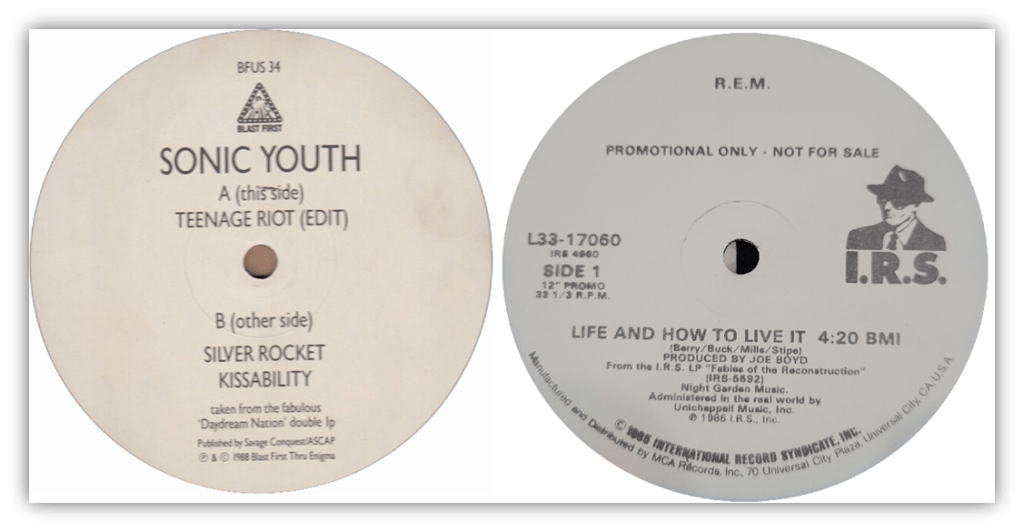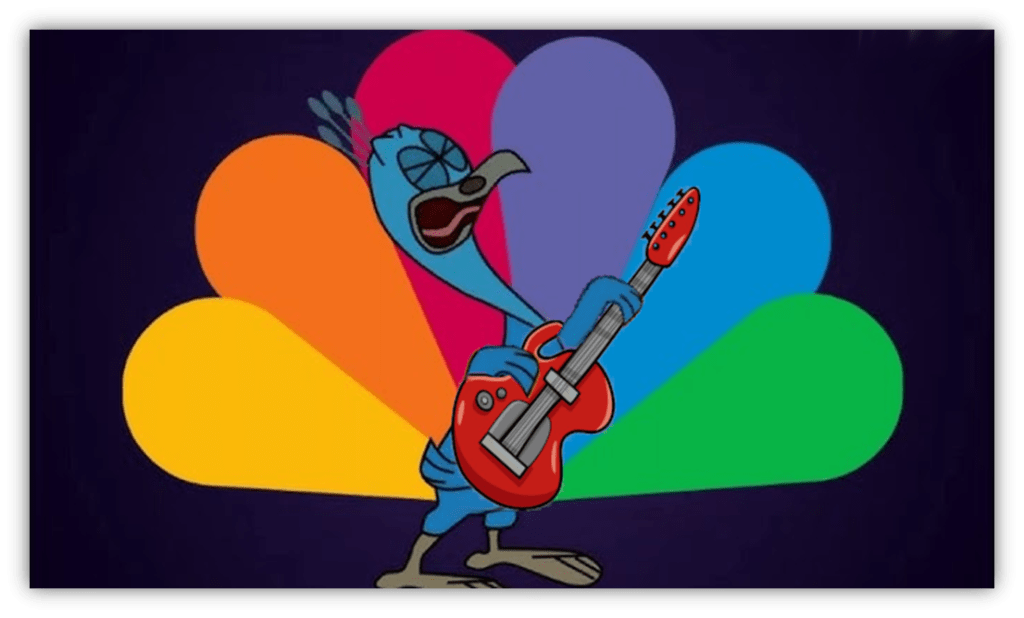One day, when I was in graduate school, my roommate and I had a friendly argument about music, as we tended to do.
He claimed that Sonic Youth’s “Teenage Riot”, the opening track of their 1988 masterpiece Daydream Nation, was indebted to the sound of R.E.M.’s “Life and How to Live It,” from their 1985 album Fables of the Reconstruction.
Now, I didn’t necessarily disagree.

There’s clearly a similarity in sound and structure—the progression from dreamy guitar chimes to full-on rockin’ post-punk played at a breakneck speed.
It’s possible Sonic Youth were fans of R.E.M. and took some ideas for their song. But I happen to think it likely that the primary influence for “Teenage Riot” came from the punk era, specifically:

“Smash It Up” by The Damned.
Moreover, it’s possible that the similarity that my roommate noted was just a coincidence. After all, the general sound of both songs—specifically the fast, tight, slashing guitar strums—was very common in a lot of punk and post-punk music.

Perhaps closest to the sound of R.E.M.’s “Life and How to Live It” was The Cure’s 1979 song “Jumping Someone Else’s Train.”

There was also Modern English’s “I Melt With You” from 1982, which took the sound to the Hot 100—albeit at #78.
And let’s not forget the classic single that inspired so much post-punk to follow, Joy Division’s “Love Will Tear Us Apart.”

Not long after this discussion with my roommate, I discovered Nick Cave’s album with his first band, The Boys Next Door. Their song “Somebody’s Watching” featured similar breakneck guitar strums. There it was again.
What was this musical flourish called? I had no idea, so I simply went with my gut.
I thought of it as the “punk peacock strum.”
Hearing Nick Cave’s band do the punk peacock so soon after my discussion about Sonic Youth and R.E.M., I was prompted to think more carefully about its ancestry and evolution.
When it comes to early precursors, I can only take some guesses.

Buddy Holly seems like an important influence. Specifically his jittery electric guitar chimes in “Words of Love.”
At the very least, those chimes inspired The Searchers, who peppered some of their songs with quickly strummed flourishes. Like in their biggest hit, “Needles and Pins.”
However, I think the most important distant precursor was in fact an acoustic strum.

On The Beatles’ “Things We Say Today” from 1963, Paul McCartney decorates the song with flamboyant guitar punctuation, likely inspired by flamenco. This is pretty darn close to our sound!
I had a notion that Pete Townsend would be an important influence in spreading around this guitar flourish. And Pete definitely toyed with flamenco-inspired strums in some Who songs, perhaps most notably in “Pinball Wizard” from 1969. But never as a strong, exclamatory sort of punctuation like the true punk peacock.

If anything, Pete was strumming semicolons and ellipses.
In fact, the next important link in the chain was The Yardbirds. On “Heart Full of Soul” from 1965, Jeff Beck mixed a droning electric riff with acoustic strum flourishes similar to McCartney’s. Then, two years later, Jimmy Page joined the band, and gave some bright electric strums to “Tinker, Tailor, Soldier, Sailor.”
But the day the strum became a full-on peacock strum was the day in 1968 that the Rolling Stones released “Jumpin Jack Flash.”

Bright and bold as can be, Keith Richards’ electric strum flourishes just perfectly embody the brash, preening exhibitionism of cocksure young rebels.
It’s not surprising that other guitarists worked the peacock strum into some of their own songs.

- Dave Davies of the Kinks.

- Phil Manzanera of Roxy Music.
When it comes to exuding ‘tude, that strum does set the mood.
Even less surprising is that the early punk bands grabbed onto Keith Richard’s flashy guitar flourish for their own songs of brash youthful abandon. Variations of the peacock strum can be heard in songs by The Stooges, The Dictators, and Pere Ubu, and The Sex Pistols.
And the Pistols connection may be the most important of all.

Steve Jones’ ringing strums in “Holiday in the Sun” are full-on punk and full-on peacock. This likely served as the template sound for countless bands to follow.

From there you get John McKay of Siouxsie and the Banshees strumming like crazy in “Hong Kong Garden” and “Helter Skelter.”
- You get Sham 69 uniting the kids.
- You get Joy Division tearing apart.
- You get no action from Elvis Costello.
- You get the passion of Bauhaus.
And The Cure, and XTC, and Modern English, and R.E.M., and Sonic Youth, and the Pixies, and the Wedding Present, et cetera, et cetera.
It’s a stretch to say it’s everywhere now.
But despite being a niche musical flourish, the punk peacock strum has been thoroughly entrenched in the indie music world.

← Does this thing actually have a name that I don’t know about?
Well, too bad! I calls it what I calls it.
Here’s a playlist to get your heart strings a-strummin’, punk peacock style!

Let the author know that you liked their article with a “Green Thumb” Upvote!





It may indeed have another name, but I like “punk peacock.” It connotes the sound and attitude perfectly. Great job, Phylum!
I don’t know if strum you are talking about has an official name, so your name suits it just fine. I think your choice of Buddy Holly is a good entry point into its origins. The other references you make that I am familiar with make sense to me. Definitely hearing Townshend. I would add Lou Reed’s playing as a big influence.
Interesting. I hadn’t considered Lou. What songs would you say showcase that influence?
I’m Waiting for the Man and the later part of Heroin both have that driving feel with basic chords that came to define a lot of punk. That album with Nico only sold about 30,000 copies, but it inspired so many genres of music that were to follow. Brian Eno joked that every one of those people that bought the album went out and started a band.
You’re right. I guess I was distracted with all of the other instruments going on. I mean: I guess, but I just don’t know. 😎
Do you mean the quick triplets landing on the one? Like da-da-daaaaahhh….? I’m pretty sure it comes from flamenco, like you said, though Spanish guitar is played without a pick, like so:
https://youtu.be/enU9tYmF_vw
Most rock and punk guitarists use a pick so triplets are done with a quick swivel of the wrist, either down-up-down or up-down-up. I’ve seen Pete Townshend and others palm the pick to play with the fingers and then switch back. Sometimes you’ll see them have a dozen picks in a holder on the mic stand and it’s not necessarily because they’re butterfingers, but because they’ll intentionally drop the pick to do some finger picking and then grab another pick off the stand.
Anyway, I’ve always called it a triplet. There may be a more official name, but I’m calling it the punk peacock from now on.
I see. I guess an alternative name could be “the Troubador’s Triplet.” Or maybe “the Triplets of Hellville?”
But punk peacock will always be my go-to.
This is the one that came to mind for me. Peacock sighting at about :05, as the second chord is strummed:
https://www.youtube.com/watch?v=pT1rseqUrsc
Sighting confirmed.
Also: I had completely forgotten about this song!
Does this fit the description?
https://www.youtube.com/watch?v=OgtQj8O92eI
Definitely an ancestor! Possibly the earliest case of flashy strumming in rock? And apparently it originally came from The Crickets, so that makes sense. It’s a good deal closer in sound to punk peacock than the guitar of “Words of Love” though. Great pick.
I’m sure I’ll have plenty of these in my collection but I can’t get the intro to Pinball Wizard out of my mind.
Great topic and playlist.
On a side note, i don’t know if Bowie has any examples but I’ll shoehorn this in anyway as you’re a fan. Currently on a family road trip and visiting the town of Aylesbury found this, titled Earthly Messenger. Erected to honour the fact that Hunky Dory and Ziggy Stardust both had their live premieres at Aylesbury’s Friars Theatre. It’s not the worst scultpure I’ve ever seen but the facial features are on the freaky side. ‘Divisive’ is the word that seems to be attached to it.
Terrifying.